Mike Saunby got his hands on one of the most interesting old clocks I have ever seen. It does time and date which isn’t any great feat by todays standards but have a look at the complex electro-mechanical goodness that makes it tick. The big question here is who made the thing, there are no markings on the clock to give us any clues. Anyone know? There are some high resolution pictures here.
"The clock mechanism
The clock relies almost entirely on electro mechanical switches. The time source is a drop in "module" comprising a 240V 50cps synchronous electric motor with gearbox giving one RPM. Attached to this is a cam which activates a switch that looks to have been taken from a relay similar to those used elsewhere in the clock. This gives one pulse per minute.
The rest of the mechanism is built from relays and uniselectors and counts minutes, tens of minutes and hours. These are displayed in two rows of lamps, the top row being hours (1 to 12) the first five lamps of the second row being tens of minutes and the remaining ten lamps being minutes (0 to 9). Further sophistication (complication) is found in the alarm and reset operations.
The calendar mechanism
This is entirely mechanical. Every 12 hours a lever is pressed and this advances the day dial, e.g. A.M. Mon advances to P.M. Mon. There’s also a date dial and a month dial. The month dial has a cam to set the number of days in the month. February has 28 days on the cam, but every 4 years this is advanced to 29 by an extra lever pushed into place by an extra wheel that advances every 6 months and completes one revolution every 4 years. A nice touch!"

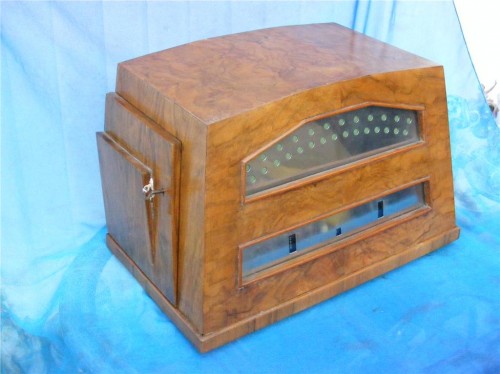
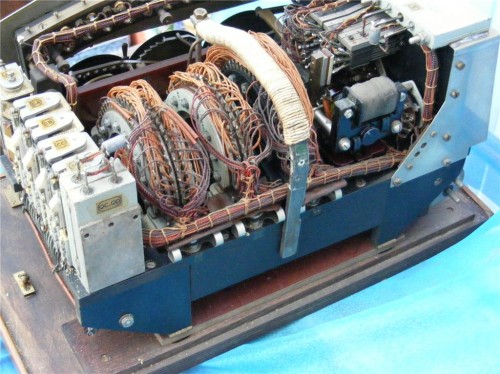

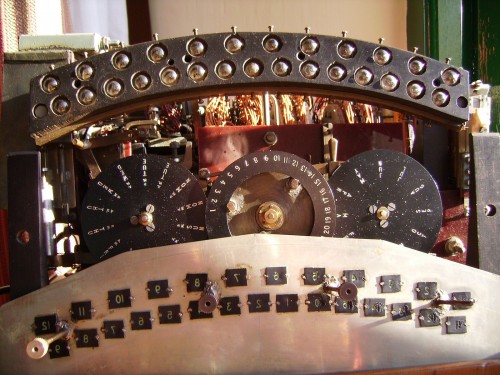
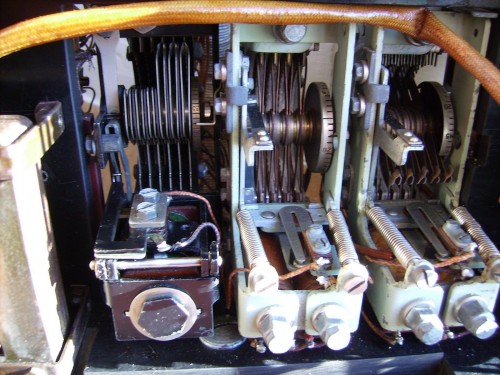
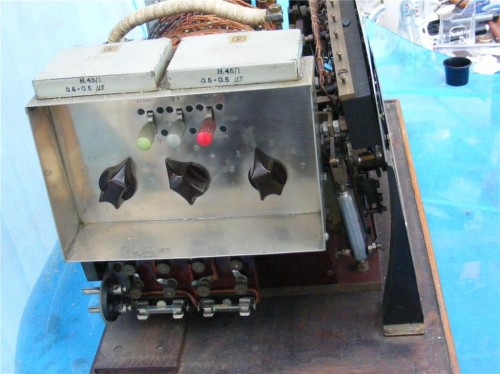
Permalink
The coils and the ratchets on the dials look the same as those from an old (1940s) pinball game (used to talley and project the score). This clock might be a one-off/prototype/employee-diy item from a pinball maker.
Just an idea.
Neil
Permalink
I looks like something from my grandpa’s time machine! What a paradox…
Permalink
Hi Neil,
You are right, it does look like old pinball parts.
Permalink
That’s interesting, I’d assumed the mechanical parts were from some other type of clock.
I suppose after the war these kinds of parts showed up in all sorts of things. What is certain is that the electrical parts were all designed and manufactured for telephone exchange use and that during the war the only legitimate uses seem to have been for telephone and computers/code-breaking. Before the war the BBC were also using uniselectors for programme source switching.
Permalink
Looks like uniselector switches and relays from a telephone exchange. Wiring soldered, laid out and tidied using lacing twine, much as I did as an apprentice telecommunications electrician.
My guess is that this was the ‘Clock’ in a telephone exchange – we had similar units that generated the ringing and engaged tones and the timing was deemed critical 🙂
Permalink
Michael & Wayne
After I thought pinball, I thought telephone.
I’ve been inside of pinball machines—only toured one Central Office.
I wonder if Pinball companies used telephone relays?
Neil
Permalink
Given that computers were, to a large extent, the result of telephone system work it looks like you found the *original* system clock!
Permalink
imagine being 200 years in the future, and they find some of our hacked-together gadgets from the present. i don’t think that they would be able to tell what, say, a “blue-box” would be. it’s like us tryin to figure out what the Baghdad batteries were for. someone hacked it all toghether to produce something marvelous for the time, and it is a probably a one-off.
it’s a fantastic piece of work though!
Permalink
well the case looks like a cheep box clock from the 20/30’s the insides are probably from a telephone exchange my guess was it is a home build form the 60’s.
Permalink
I took the clock along to the Antiques Roadshow back in the summer. It was to be featured but didn’t make the final edit. See my blog post here http://saunby.blogspot.com/2009/10/another-time.html
It’s pretty certain that it was built in the 1940s due to a complete absence of later components and use of materials from the 1930s such as ebonite and double cotton covered wire.
Permalink
Permalink
You guys really know your pinball machines.